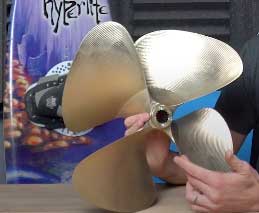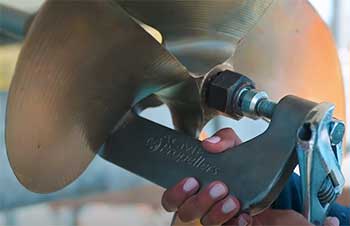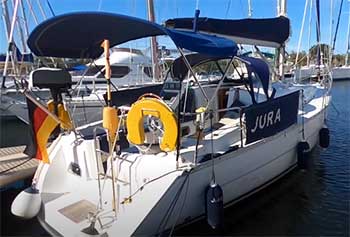Installing the right boat propeller is crucial for optimal engine performance and handling on the water. This in-depth guide will compare two of the top prop brands – OJ and ACME – to help you choose the best option for your vessel.
When selecting a boat propeller, key factors to consider include blade design, materials, durability, speed, acceleration, efficiency, and cost. By evaluating propellers on these criteria, we can gain insight into the relative strengths and weaknesses of OJ and ACME.
A Brief Comparison Table
| Factor | OJ Propellers | ACME Propellers |
| Performance | Optimized for speed and acceleration. Advanced hydrodynamic blade design. | Good performance for recreational boating but not high speed applications. |
| Strength/Durability | Very durable construction. Thick blades and protective coatings. | Decent durability for recreational use but not heavy duty applications. |
| Cost | Higher initial price but good long-term value. | More budget-friendly upfront cost. Good value. |
| Materials | Specialty alloys and treatments for strength. | Reliable aluminum and stainless alloys. |
| Availability | Broad selection but may lack some larger sizes. | Good inventory across a range of common sizes. |
| Pitch Options | Extensive choices from low to high pitch models. | Wide range of practical pitch options. |
| Technology | Cutting-edge patented propeller innovations. | Proven designs focused on practicality. |
| Reputation | Renowned for quality and performance. | Known for affordable and reliable props. |
| Customer Service | Responsive support from experts. | Helpful customer service. |
An Overview of OJ Propellers
Founded in 1918, OJ Marine has over a century of experience crafting boat propellers. The company operates its own state-of-the-art foundry and machining facility in Santa Fe Springs, California.
OJ utilizes proprietary computer-aided design technology to engineer propellers down to the smallest detail. This results in props optimized for speed, power, efficiency, and durability.
Some standout features of OJ propellers include:

- Computer controlled variable pitch design
- High performance blade area and profiles
- Polished leading edges to prevent ventilation
- Advanced hydrodynamic shaping for acceleration
- Optional anti-corrosive coatings for longevity
- Designed, cast, machined, and finished in the USA
OJ produces propellers for both high performance and recreational applications.
Their product line covers propellers for inboard, outboard, I/O, jet drive, and other marine engines.
They offer propellers in both aluminum and stainless steel. OJ uses only the highest grade alloys and precision CNC machining.
In terms of blade styles, OJ has a very extensive catalog. This includes innovative designs like high rake props, surface drive props, RPM adjustable props, and more.
Overview of ACME Marine Propellers
ACME Marine has been manufacturing boat propellers since the 1960s. They operate their own factory and foundry in Muskegon, Michigan.
ACME utilizes modern foundry and machining processes to produce affordable, quality propellers. Their prop design focuses on balance, efficiency, and durability.
Some notable features of ACME propellers:

- In-house engineering department
- Precision computer controlled casting
- Tight quality control standards
- Broad range of budget-friendly models
- Made from durable aluminum and stainless steel
- Suited for recreational and commercial boats
- Good availability through dealers
ACME’s propeller lineup includes models for outboard motors, inboard engines, I/O drives, jet drives, and more.
They cover a wide gamut of blade designs and pitches for various boating applications.
In terms of materials, ACME offers cost-effective aluminum props as well as corrosion resistant stainless steel. Their manufacturing process allows them to produce quality propellers at relatively affordable prices.
Comparing OJ and ACME on Critical Factors
Now let’s do a side-by-side comparison of some key factors that differentiate OJ and ACME marine propellers.
- Performance
OJ propellers are specially engineered for maximum speed and acceleration. Their advanced hydrodynamically designed blades offer unmatched performance for racing, speed boats, and high demand applications.
ACME props are also well-designed for balance and efficiency. But they are geared more for general recreational boating rather than all-out speed.
For specialty high performance vessels, OJ is the clear choice. ACME works well for more casual power boating needs.
- Strength and Durability
OJ constructs their propellers for maximum strength and longevity under punishing conditions. The use thick, robust blades along with leading edge polishing and protective coatings.
ACME props are plenty durable for most boating needs. But OJ’s construction gives them the advantage for endurance in extreme racing environments.
For general recreational use, ACME offers good longevity. OJ excels for strength and resilience under high impacts.
- Cost Considerations
Due to their affordable high volume production, ACME propellers typically have a lower purchase price than OJ models. ACME represents a great value for the performance.
OJ props come with a higher initial investment. But their optimized performance and long service life can justify the extra cost for serious boaters.
For those on a tight budget, ACME is the most economical choice. If money is no object, OJ provides the ultimate in speed and durability.
- Availability
Both OJ and ACME have wide distribution networks through marine supply stores and dealers. For common motor sizes, you’ll find abundant availability and inventory for either brand. OJ may have a slight edge in stocking larger or less common sizes.
- Materials
OJ and ACME both produce propellers using high quality aluminum and stainless steel alloys. OJ is more likely to utilize specialized proprietary alloys and treatments like nickel-copper. Both meet marine grade standards for corrosion and abrasion resistance.
- Pitch Options
You’ll find extensive pitch options available from both brands ranging from about 10 to over 30 inches. The styles and sizes covered are very similar between OJ and ACME. Both aim to offer practical pitch choices ideal for particular boat types and motor applications.
- Technological Advancements
OJ places more focus on continually developing state-of-the-art propeller technology. They actively research and patent new designs to extract maximum performance.
ACME relies more on proven, time-tested propeller engineering rather than bleeding edge tech. Their designs emphasize practicality and value.
For those seeking the latest prop innovations, OJ is the leader. ACME takes a more conservative approach focused on fundamentals rather than flash.
- Quality Reputation
Both OJ and ACME produce well-made propellers that meet industry standards. OJ’s intense design analysis and testing results in a stellar reputation for quality among performance enthusiasts. But ACME also has a strong following among more cost-conscious boaters.
- Customer Service
You can expect responsive customer service from knowledgeable staff at either company. Both OJ and ACME have in-house experts to help troubleshoot prop issues and guide customers to the right product. But if you love ACME, here is how to install it.
Direct Comparison of OJ And ACME Props
Here we’ll provide a head-to-head look at how OJ and ACME propellers stack up across various marine applications.
- Outboard Motor Propellers
For beefy outboards that demand speed, OJ’s high performance designs can’t be beat. They offer durable stainless props with innovative blade geometries ideal for racing outboards.
ACME has a solid lineup of affordable aluminum props for mid-range and smaller recreational outboards. Their designs focus more on affordability than peak speed.
- Inboard Engine Propellers
OJ’s stainless steel line caters nicely to high performance inboard configurations. Their advanced designs optimize for speed and acceleration with inboard power plants.
ACME supplies quality value-priced aluminum propellers for inboard engines used in family and fishing boats. Their economical props get the job done without breaking the bank.
- I/O and Sterndrive Propellers
OJ produces specialized grade stainless props to enhance speed from I/O and sterndrive systems. Their innovative blade shapes account for the unique demands of these driveline configurations.
For sterndrives used for water sports and light duty cruising, ACME aluminum props offer reliable performance at lower cost.
- Propellers for Jet Boats
Here again OJ is the leader in engineering state-of-the-art stainless steel propellers for jet boat racing and recreation. Their lab-tested designs account for the high RPM and loads in jet drive systems.
While less commonly used, ACME does offer a few aluminum propeller models compatible with jet drive installations if cost is a concern.
Choosing Between OJ and ACME Propellers
When deciding between these two popular American propeller brands, a few key points can help guide your decision:
- For performance boats, speed, acceleration, handling – Go with OJ.
- For recreational boating and a budget buy – ACME is a great choice.
- For innovative state-of-the-art prop technology – OJ leads the way.
- For maximum strength and durability – Choose OJ.
- For good quality at affordable pricing – ACME delivers.
- For premium high-end materials and finishes – OJ is worth the investment.
- For great availability across sizes – Both companies have you covered.
By weighing your priorities in areas like speed, cost, durability, and value, you can select the ideal propeller brand for your boating needs.
Also Read: Bass Tracker Classic XL Or Pro 170 Boat To Get?
Frequently Asked Questions (FAQ)
Still have some lingering questions about OJ and ACME propellers? Here are answers to some common queries:
ACME Marine propellers are manufactured at the company’s factory in Muskegon, MI. This facility includes their own foundry and machine shop.
OJ uses high grade aluminum and stainless steel alloys for their propellers. Their stainless props utilize alloys like 316, 317, INOX, and nickel-copper-aluminum bronze.
OJ propellers are specially engineered with high performance hydrodynamic designs best suited for speed boats seeking maximum speed.
ACME propellers range from about $150 on the low end for small aluminum props. Larger stainless steel ACME models can cost $500-800. They offer competitive pricing.
OJ props are sold through marine supply stores, boat dealerships, retailers, and online. OJ’s website has a dealer locator to help find retailers near you.
Aluminum props are more affordable but not as robust. Stainless steel offers greater strength, longevity, and corrosion resistance but with a higher price tag.
OJ’s state-of-the-art hydrodynamic blade technology gives their propellers an edge when it comes to rapid acceleration. But ACME props also deliver respectable speed.
In Conclusion
When upgrading your boat with a new propeller, both OJ and ACME offer quality American-made options. OJ propellers represent the ultimate in high performance, strength, and technology.
For an affordable prop with slightly less extremes of performance and durability, ACME is an excellent choice. Evaluate your priorities to decide if it’s worth investing extra for OJ’s advantages in speed, longevity, and technology compared to the budget-friendly qualities of ACME.
Either brand will result in noticeable improvements over a worn out prop. With the information provided in this guide, you can make an informed choice between OJ and ACME for your optimal marine propulsion.

